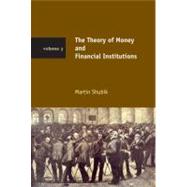
Note: Supplemental materials are not guaranteed with Rental or Used book purchases.
Purchase Benefits
What is included with this book?
| Preface | p. ix |
| Production, Exchange, Money, and Interest | |
| Exchange and Control | p. 3 |
| Production, Exchange, and Markets | p. 33 |
| Multiperiod Production and Exchange | p. 69 |
| Growth and Investment, the Real and Money Rates of Interest | p. 97 |
| Financial Institutions | |
| A Prelude to Institutions | p. 135 |
| Markets, Clearing Arrangements, and Intermediation | p. 169 |
| Corporations, Partnerships, and Proprietorship | p. 193 |
| Commercial Banking and Credit | p. 211 |
| Central Banking and the Money Supply | p. 255 |
| Stock Markets and Exchanges | p. 293 |
| Insurance and Other Financial Institutions | p. 331 |
| Corporate Control and Fiduciaries | p. 353 |
| Society and Political Economy | |
| Population and Labor | p. 385 |
| Multigenerational Economics | p. 407 |
| Public Goods and Public Policy | p. 423 |
| Taxes, War, History, and National Debt | p. 447 |
| Government and Central Banking: Monetary and Fiscal Policy | p. 471 |
| A Critique of Macroeconomics: Policy and/or Theory | p. 499 |
| Mathematical Institutional Economics | |
| Solutions to Games in Extensive Form, Rationality, and Experimental Gaming | p. 531 |
| Money: A Cooperative Market Game Approach | p. 567 |
| Money and Financial Institutions: Invariant Function and Changing Form: A Reprise | p. 595 |
| References | p. 627 |
| Name Index | p. 655 |
| Subject Index | p. 663 |
| Table of Contents provided by Ingram. All Rights Reserved. |
The New copy of this book will include any supplemental materials advertised. Please check the title of the book to determine if it should include any access cards, study guides, lab manuals, CDs, etc.
The Used, Rental and eBook copies of this book are not guaranteed to include any supplemental materials. Typically, only the book itself is included. This is true even if the title states it includes any access cards, study guides, lab manuals, CDs, etc.